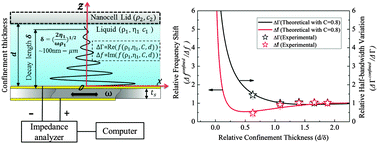Modeling the response of a quartz crystal microbalance under nanoscale confinement and slip boundary conditions
Abstract
Nanorheology and boundary slip play an important role in the micro/nanofluidics, and micro/nano-electromechanical systems, especially for research on DNA, proteins and polymers. Herein, a nanoscale confinement structure, called a nanocell, is established by assembling a parallel plate on the quartz crystal microbalance (QCM) chip to study the nanorheology of liquids and the boundary slip on the interface. The corresponding analytical models are established and verified experimentally with high consistency. We reveal that the responses of QCM with the nanocell assembled are dependent on the nanocell confinement thickness, the acoustic impedance of the nanocell lid (parallel plate), as well as the boundary slip on the interface. A critical influence thickness of the assembled nanocell d = 2δ is indicated, above which the assembly of a nanocell has no influence on the QCM response. And the interfacial boundary slip results in obvious decreases of relative frequency shift and relative half-bandwidth variation. We find that adopting a nanocell lid with the same acoustic impedance as the tested liquids will evidently simplify the experimental analysis. In the paper, the nanocell provides an effective method to investigate the nanorheology of confined liquids and the interfacial boundary slip, and the established models offer a theoretical basis for the analysis of the nanocell-assembled QCM response.


 Please wait while we load your content...
Please wait while we load your content...